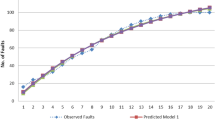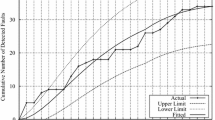Abstract
Traditional software deployment readiness criteria, such as “zero severity one defects”, do not provide any indication of how reliable the product will be in the field. In this paper, we propose a software reliability prediction framework to achieve data-driven, customer focused reliability and availability assessment throughout the entire development life cycle. Focusing on front-end reliability and availability improvement, the framework starts with availability evaluations as early as the architecture design phases. Markov-based architecture reliability models are used to study the failure and failure recovery mechanisms of the systems and solutions. These early evaluations can help architecture design, reliability requirement setting and reliability budget allocation. The early phase models and predictions can be updated as testing data becomes available. Software reliability growth models (SRGMs) are used to estimate one of the most influential parameters, i.e., the failure rates of software. Estimation of other reliability parameters, such as coverage factor, silent failure detection times and recovery durations and success probabilities are also discussed in this paper. This framework also calibrates test data with field observations, and thus forms a close-loop approach to evaluate the reliability and availability of the software product to verify that the product meet specific reliability expectation.
Similar content being viewed by others
References
Akaike, H. (1974), “A New Look at Statistical Model Identification”, IEEE Transactions on Automatic Control, 19, 1974, pp. 716–723.
Bauer, E., Zhang, X., Kimber, D., Practical Reliability Engineering, John Wiley and Sons, New York, to appear in March 2009.
Goel, A. L. and Okumoto, K. (1979), “Time-Dependent Fault Detection Rate Model for software and Other Performance Measures”, IEEE Transactions on Reliability, Vol. 28, pp. 206–211.
Gokhale, S. et al. (2002), “Reliability Prediction and Sensitivity Analysis Based on Software Architecture”, in Proc. 13th Int. Symp. on Software Reliability Eng., 2002, 64–75.
Huang, C, Kuo, S, and Chen, I. (1997), “Analysis of a Software Growth Model with Logistic Testing-Effort Function”, Proceedings of the Eighth International Symposium On Software Reliability Engineering, 2–5 Nov. 1997 pp 378–388.
Jeske, D. R., Zhang, X. and Pham, L. (2001), “Accounting for Realities When Estimating the Field Failure Rate of Software”, Proceedings of the, pp. 12th International Symposium on Software Reliability Engineering332–339.
Jeske, D.R., Zhang, X., and Pham, L. (2005), “Adjusting Software Failure Rates that Are Estimated from Test Data”, IEEE Trans. on Reliability, 54 (1), 107–114.
Jeske, D.R., and Zhang, X. (2005), “Some Successful Approaches to Software Reliability Modeling in Industry”, Journal of Systems and Software,, 74(1), 85–99.
Lyu, M. (ed.) (1996), Handbook on Software Reliability Engineering, New York: McGraw-Hill.
Ohba, M. (1984), “Inflexion S-shaped Software Reliability Growth Models”, In Stochastic Models in Reliability Theory, Osaki, S. and Hatoyama, Y. (eds), Springer: Merlin, pp. 144–162.
Pham, H., and Zhang, X., (1997), “An NHPP Software Reliability Model and its Comparison”, International Journal of Reliability, Quality and Safety Engineering, vol. 4, no.3, pp. 269–282.
Pham, H, Nordmann, L., Zhang, X., (1999), “A General Imperfect Software Debugging Model with S-Shaped Fault Detection Rate”, IEEE Transactions on Reliability, Vol. 48, no.2, pp 169–175.
Pham, H. (2000), Software Reliability, Singapore: Springer.
Pham, L., Zhang, X. and Jeske, D. R. (2002), “Scaling System Test Software Failure Rate Estimates for Use in Field Environments”, Proceedings of the Annual Conference of the American Statistical Association, pp. 2692–2696.
Pham, H and Deng, C. (2003), “Predictive-Ratio Risk Criterion for Selecting Software Reliability Models”, Proceeding of the Ninth ISSAT International Conference on Reliability and Quality in Design, Honolulu, Hawaii, pp. 17–21.
Teng, X. and Pham, H. (2004), “A Software Cost Model for Quantifying the Gain with Considerations of Random Field Environments”, IEEE Transactions on Computer, Vol. 53, no. 3, pp. 380–384.
Wang, W., “Architecture-based Software Reliability Modeling”, Ph.D. thesis in Computer Science Department, University at Albany, State University of New York, 2002.
Xie, M. (1991), Software Reliability Engineering, Singapore: World Scientific.
Yamada, S., Ohba, M. and Osaki, S. (1983), “S-shaped Reliability Growth Modeling for Software Error Detection”, IEEE Transactions on Reliability, Vol. 12, pp. 475–484.
Yamada, S., Tokuno, K., and Osaki, S., (1992), “Imperfect debugging models with fault introduction rate for software reliability assessment”, International Journal of Systems Science, vol. 23, no. 12.
Yamada, S., Hishitani, J., and Osaki, S., (1993), “Software Reliability Growth with a Weibull Test Effort: A Model & Application”, IEEE Transactions on Reliability, Vol., 42, No. 1, pp 100–106.
Zhang, X. and Pham, H., (2000), “Comparison of non-homogeneous Poisson Process Software Reliability Models and its Applications”, International Journal of System Science, vol. 31, no. 9, pp. 1115–1123.
Zhang, X., Jeske, D. R. and Pham, H. (2002), “Calibrating Software Reliability Models When Test Data Does Not Reflect the User Operational Profile”, Journal of Applied Stochastic Models in Business and Industry, Vol. 18, pp. 87–99.
Zhang, X., Sharma, M., and Franklin, P. H., “Evaluating System Reliability from the Customer Perspective to Improve Availability Predictions”, Reliability, Availability, Maintainability Symposium 2005, Alexandria, Virginia.
Zhang, X. and Pham, H., “Field Failure Rate Prediction Before Software Deployment”, Journal of Systems and Software, to appear.
Zhang, X., “Software Reliability and Risk Management”, Chapter in Handbook of Enterprise Integration, Taylor and Francis Group, LLC, New York, USA, to appear in 2008.
Author information
Authors and Affiliations
Rights and permissions
About this article
Cite this article
Zhang, X., Pham, H. Data-Driven Software Reliability and Availability Modeling and Prediction. OPSEARCH 45, 335–350 (2008). https://doi.org/10.1007/BF03398824
Received:
Published:
Issue Date:
DOI: https://doi.org/10.1007/BF03398824




